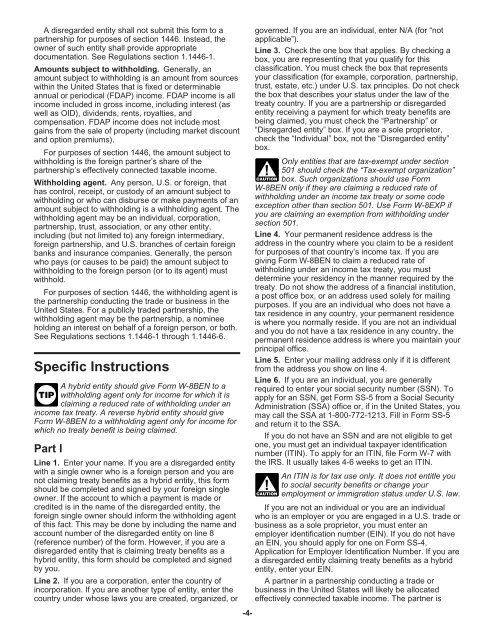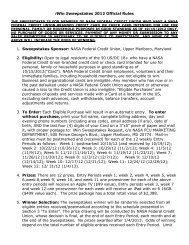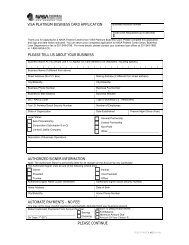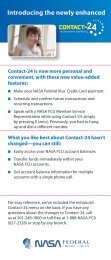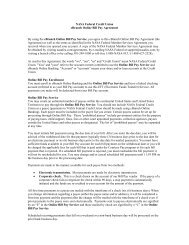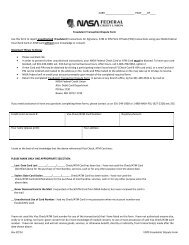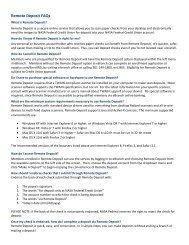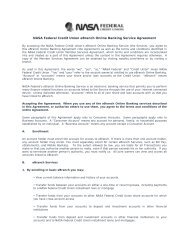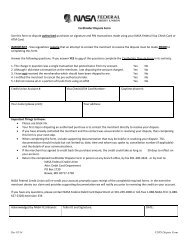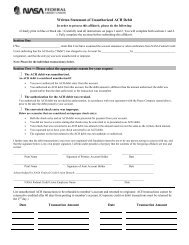Form W-8BEN (Rev. February 2006) - NASA Federal Credit Union
Form W-8BEN (Rev. February 2006) - NASA Federal Credit Union
Form W-8BEN (Rev. February 2006) - NASA Federal Credit Union
Create successful ePaper yourself
Turn your PDF publications into a flip-book with our unique Google optimized e-Paper software.
A disregarded entity shall not submit this form to a<br />
partnership for purposes of section 1446. Instead, the<br />
owner of such entity shall provide appropriate<br />
documentation. See Regulations section 1.1446-1.<br />
Amounts subject to withholding. Generally, an<br />
amount subject to withholding is an amount from sources<br />
within the United States that is fixed or determinable<br />
annual or periodical (FDAP) income. FDAP income is all<br />
income included in gross income, including interest (as<br />
well as OID), dividends, rents, royalties, and<br />
compensation. FDAP income does not include most<br />
gains from the sale of property (including market discount<br />
and option premiums).<br />
For purposes of section 1446, the amount subject to<br />
withholding is the foreign partner’s share of the<br />
partnership’s effectively connected taxable income.<br />
Withholding agent. Any person, U.S. or foreign, that<br />
has control, receipt, or custody of an amount subject to<br />
withholding or who can disburse or make payments of an<br />
amount subject to withholding is a withholding agent. The<br />
withholding agent may be an individual, corporation,<br />
partnership, trust, association, or any other entity,<br />
including (but not limited to) any foreign intermediary,<br />
foreign partnership, and U.S. branches of certain foreign<br />
banks and insurance companies. Generally, the person<br />
who pays (or causes to be paid) the amount subject to<br />
withholding to the foreign person (or to its agent) must<br />
withhold.<br />
For purposes of section 1446, the withholding agent is<br />
the partnership conducting the trade or business in the<br />
United States. For a publicly traded partnership, the<br />
withholding agent may be the partnership, a nominee<br />
holding an interest on behalf of a foreign person, or both.<br />
See Regulations sections 1.1446-1 through 1.1446-6.<br />
governed. If you are an individual, enter N/A (for “not<br />
applicable”).<br />
Line 3. Check the one box that applies. By checking a<br />
box, you are representing that you qualify for this<br />
classification. You must check the box that represents<br />
your classification (for example, corporation, partnership,<br />
trust, estate, etc.) under U.S. tax principles. Do not check<br />
the box that describes your status under the law of the<br />
treaty country. If you are a partnership or disregarded<br />
entity receiving a payment for which treaty benefits are<br />
being claimed, you must check the “Partnership” or<br />
“Disregarded entity” box. If you are a sole proprietor,<br />
check the “Individual” box, not the “Disregarded entity”<br />
box.<br />
Only entities that are tax-exempt under section<br />
! 501 should check the “Tax-exempt organization”<br />
CAUTION box. Such organizations should use <strong>Form</strong><br />
W-<strong>8BEN</strong> only if they are claiming a reduced rate of<br />
withholding under an income tax treaty or some code<br />
exception other than section 501. Use <strong>Form</strong> W-8EXP if<br />
you are claiming an exemption from withholding under<br />
section 501.<br />
Line 4. Your permanent residence address is the<br />
address in the country where you claim to be a resident<br />
for purposes of that country’s income tax. If you are<br />
giving <strong>Form</strong> W-<strong>8BEN</strong> to claim a reduced rate of<br />
withholding under an income tax treaty, you must<br />
determine your residency in the manner required by the<br />
treaty. Do not show the address of a financial institution,<br />
a post office box, or an address used solely for mailing<br />
purposes. If you are an individual who does not have a<br />
tax residence in any country, your permanent residence<br />
is where you normally reside. If you are not an individual<br />
and you do not have a tax residence in any country, the<br />
permanent residence address is where you maintain your<br />
principal office.<br />
Line 5. Enter your mailing address only if it is different<br />
Specific Instructions from the address you show on line 4.<br />
A hybrid entity should give <strong>Form</strong> W-<strong>8BEN</strong> to a<br />
TIP withholding agent only for income for which it is<br />
claiming a reduced rate of withholding under an<br />
income tax treaty. A reverse hybrid entity should give<br />
<strong>Form</strong> W-<strong>8BEN</strong> to a withholding agent only for income for<br />
which no treaty benefit is being claimed.<br />
Part I<br />
Line 1. Enter your name. If you are a disregarded entity<br />
with a single owner who is a foreign person and you are<br />
not claiming treaty benefits as a hybrid entity, this form<br />
should be completed and signed by your foreign single<br />
owner. If the account to which a payment is made or<br />
credited is in the name of the disregarded entity, the<br />
foreign single owner should inform the withholding agent<br />
of this fact. This may be done by including the name and<br />
account number of the disregarded entity on line 8<br />
(reference number) of the form. However, if you are a<br />
disregarded entity that is claiming treaty benefits as a<br />
hybrid entity, this form should be completed and signed<br />
by you.<br />
Line 2. If you are a corporation, enter the country of<br />
incorporation. If you are another type of entity, enter the<br />
country under whose laws you are created, organized, or<br />
-4-<br />
Line 6. If you are an individual, you are generally<br />
required to enter your social security number (SSN). To<br />
apply for an SSN, get <strong>Form</strong> SS-5 from a Social Security<br />
Administration (SSA) office or, if in the United States, you<br />
may call the SSA at 1-800-772-1213. Fill in <strong>Form</strong> SS-5<br />
and return it to the SSA.<br />
If you do not have an SSN and are not eligible to get<br />
one, you must get an individual taxpayer identification<br />
number (ITIN). To apply for an ITIN, file <strong>Form</strong> W-7 with<br />
the IRS. It usually takes 4-6 weeks to get an ITIN.<br />
!<br />
CAUTION<br />
An ITIN is for tax use only. It does not entitle you<br />
to social security benefits or change your<br />
employment or immigration status under U.S. law.<br />
If you are not an individual or you are an individual<br />
who is an employer or you are engaged in a U.S. trade or<br />
business as a sole proprietor, you must enter an<br />
employer identification number (EIN). If you do not have<br />
an EIN, you should apply for one on <strong>Form</strong> SS-4,<br />
Application for Employer Identification Number. If you are<br />
a disregarded entity claiming treaty benefits as a hybrid<br />
entity, enter your EIN.<br />
A partner in a partnership conducting a trade or<br />
business in the United States will likely be allocated<br />
effectively connected taxable income. The partner is


